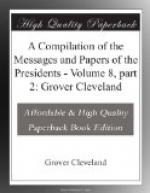In view of such professional judgment, and considering the interests which would be interfered with by the location of piers in the river, and having due regard to the judgment of the legislature of the State of New York, it seems to me that a plan necessitating the use of piers in the bed of the river should be avoided. The question of increased expense of construction or the compromise of conflicting interests should not outweigh the other important considerations involved.
I notice the bill provides that the companies availing themselves of its privileges shall receive no greater pay for transporting the mails across the bridge than is allowed per mile to railroads using the same. If this is intended, as the language seems to import, to authorize this bridge company to charge the United States Government a toll for the carriage of its mails across the bridge equal to the amount which may be paid per mile by the Government for carrying the mails by railroads crossing the bridge, it seems to me it should not be allowed. The expense to the Government for carrying the mails over the structure should beyond any doubt be limited to the compensation paid the railroads for transportation.
An exceedingly important objection to the bill remains to be considered. In 1890 the North River Bridge Company was incorporated by an act of Congress for the purpose of constructing a bridge across the North River, the New York terminus of which was located at or near Twenty-third street in the city of New York. The proposition to construct the bridge at that point was a subject very carefully and thoroughly examined at that time and during the agitation of the project for a number of years prior to the passage of the act. As a result of such examination and much discussion, Congress granted permission to this company to construct a bridge having a single span and suspended from towers on each side of the river, and in the act especially prohibited the placing of any piers in the river, either of a temporary or of a permanent character, in connection with said bridge. This plan to bridge the river without piers was at that time considered feasible by the engineers of the company, and it accepted the terms of the act. Before this permission was finally granted a number of bills were introduced in the Congress covering the same subject, which were referred to Government engineers. Reports were made by these officers in every case insisting upon a construction with a single span and without piers in the bed of the river.
The eighth subdivision of the bill herewith returned provides that any company heretofore created for the purpose of bridging the river may avail itself of the provisions of the act, and makes such company subject to all its provisions. This, of course, has reference to the North River Bridge Company and releases that company from the prohibition of the act under which it was permitted to span the river




